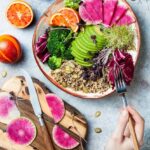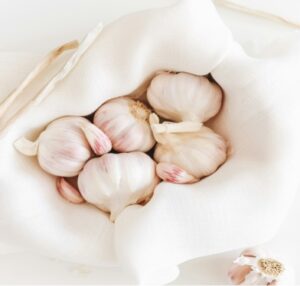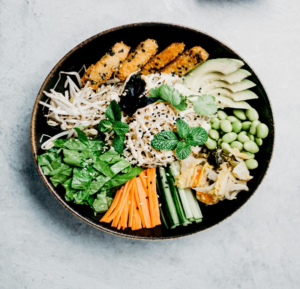
Someone (maybe even me!) has told you that you have an overgrowth of Candida, right? And now you feel thrilled to know the cause of your symptoms, but also ready to do some fungi murdering with a Candida diet.
Candida is a fungus that is commonly found in the digestive tract and many other areas of the body, including the mouth, ears, nose, toenails, vagina, and yep, you guessed it, your GI tract. Usually, Candida hangs out in your gut, happily co-existing with the other organisms and assisting with digestion, but when the environment is not optimal, Candida can overgrow and cause symptoms that are a real problem.
The beneficial bacteria in your gut usually keep Candida in line, but certain things can allow it to thrive and take over.
What things you ask?!
Antibiotics can kill off some of your beneficial bacteria, so there are fewer members of your protective army, stress affects the composition of your gut, favoring the more harmful organisms, use of PPIs or other acid reducing meds can allow Candida to grow, e-cigarette use, and you know those bags and bags of potato chips that you’ve been scarfing?… those affect whether Candida can thrive as well.
Symptoms of Candida Overgrowth
If you suspect an overgrowth of Candida, there are some symptoms associated that may help you to determine whether this is a potential issue. They include:
- abdominal pain
- constipation
- diarrhea
- bloating
- reflux
- food sensitivities
- insane sugar cravings
- brain fog
- eczema or other skin conditions
- fatigue
- weight gain
- joint or muscle pain
- anxiety or depression
- mood swings
- yeast infections
- headaches, and
- heart palpitations
Sounds fun, huh?
The problem with this list of symptoms is that it’s really general, isn’t it? Similar symptoms can be caused by H. pylori, histamine-producing bacteria, food intolerances, or even some parasites.
And you can see from our list of potential symptoms, your gut health impacts your entire body, and the foods you eat and whether they help Candida to prosper in your body is a huge factor in how you feel on a daily basis. And you can feel like utter garbage with too much Candida in your body.
Can You Really Eliminate Candida?
Some organisms, like C. difficile, are serious trouble-makers and they can be present in your gut long-term, but luckily, you can definitely get rid of Candida with a Candida Diet. It is a particularly stubborn opponent and is hard to eliminate quickly for several reasons. First, it can morph itself to live in most areas of your body and in all conditions. Acidic… no problem. Alkaline… equally as awesome. Second, Candida has Spidey-like adhesion properties, so it can adhere to cells easily. Third, Candida forms biofilms to protect itself and evade detection from your immune system. Trickly little bugger. Fourth, it can break down the tight junctions in your gut lining and penetrate epithelial cells. Fifth, it has a double cell wall, so it’s more difficult to penetrate with both antifungals or herbal treatment. And last, it can shape-shift from its fungal form to its more pathogenic form, just like a wizard.
Tough to figure it all out, right?
Luckily, we can test for the presence of Candida with a comprehensive gut microbiome test. You’ll know if Candida is an issue for you as well as any co-infections that are present. Oh yeah, Candida loves to hang out with its BFFs like H. pylori, Streptococcus, Enterococcus, and Pseudomonas… all pretty bad players to be buddies with, if you ask me. These co-infections can make treating Candida even more difficult.
Diet and Candida
What you eat has a massive impact on whether harmful bacteria thrive or not, and the same is said for our little fungus friend, Candida, although it is much more adaptable to different foods.
A diet to help clear Candida should be in place for the long-term. How long? We typically treat Candida for 2 – 3 months, depending on the level at the onset. We recommend continuing the Candida Diet for at least 4 months after treatment has stopped.
A whole food, plant-forward diet will work wonders in regards to how you feel on a daily basis while you are treating Candida. Adequate good-quality protein is equally as important. Meals should be spaced out and snacks should be limited, since constantly feeding yourself is constantly feeding Candida as well.
How Does the Candida Diet Work?
Basically, what you want to do first when you plan to begin any type of elimination diet is to decide which foods you plan to eliminate and which you plan to eat. Certain foods have been shown to help promote the growth of Candida while others have the ability to help slow its growth. Removing the Candida-promoting foods from your sight can make adherence and meal prep a bit easier… just hide them in a box on the top shelf of the pantry and no one’s the wiser.
Foods to Avoid
Foods to avoid while treating a Candida overgrowth include:
- Processed carbohydrates such as chips, crackers, cookies, cakes, anything made with white flour, gluten-free substitutes for these foods, etc. These processed carbs are highly inflammatory and will create a feeding frenzy for Candida
- High sugar fruit such as banana, pineapple, mango, papaya, watermelon, grapes, dried fruit… you get the idea and fruit juices
- Foods that often contain mold: peanuts and other nuts, mushrooms (except white button mushrooms), wine, and chocolate
- Sports drinks and energy drinks
- Candy
- Dairy and non-dairy desserts like ice cream, sorbet, frozen yogurt, etc.
- All sugars including honey
- Yeast breads and gluten-free breads
- Cereal and high-carb grains like oats, rice, corn, etc.
Foods to Eat
The best foods to eat during a Candida diet are those that are anti-inflammatory and do not feed Candida. These include:
- Non-starchy veggies like broccoli, cauliflower, Brussels sprouts, asparagus, zucchini, etc.
- A big fat salad like this one
- Healthy fat like avocado, coconut oil, olive oil, and avocado oil
- Quality protein sources
- Fermented foods
- Berries, especially blueberries – eat daily if you tolerate them
- Limited amounts of whole grains
- Limited amounts of starchy veggies like squash, beets, carrots, and sweet potatoes
- Try this breakfast bowl and this fried cauliflower rice
Treatment Considerations
You have options when it comes to treating Candida. You can use anti-fungal pharmaceuticals like Nystatin, herbal treatments, or a combination. If you choose to use a pharmaceutical, you’ll want to use a biofilm disruptor like black cumin seed oil as well. Talk to your doctor about the best option for you that takes into account your Candida level and overall health status.
Botanicals
Herbal treatments can be as effective as antifungal medicines, but they typically take a little longer to work. The upside is that there is usually less impact to your beneficial bacteria and gut environment as a whole. Some very effective botanical herbs that work wonderfully when taken in concentrated supplement form to eliminate Candida are:
- Black walnut
- Licorice root
- Cinnamon
- Oregano
- Garlic
- Lemon grass
- Thyme
- Clove
- Pau d’arco
- Grapefruit seed extract
- Green tea extract
Black walnut, garlic, and licorice root are particularly effective adhesion inhibitors, so you’ll want to include one of them to unstick Candida from your cell walls.
Nutraceuticals
Nutraceuticals are products that are derived from food sources with extra health benefits in addition to the basic nutritional value found in foods. For example, you’ve probably all heard of the potential health benefits of red wine, right? Those benefits are due to the antioxidant properties of resveratrol… that’s a nutraceutical. You typically want to take a supplement containing these ingredients, since you probably cannot drink enough wine to get an appropriate dose of resveratrol, for example. Some other nutraceuticals that are effective in the treatment of Candida include:
- Sulforaphane
- Resveratrol
- Propolis
- Caprylic acid
- Undecylenic acid
- Fiber
Other Supportive Ingredients
Besides the food you eat and the herbal supplements/nutraceuticals, many other ingredients can support your gut environment. These include:
- Probiotics, especially L. reuteri and S. boulardii
- Prebiotics
- Post-biotics such as butyrate if you are low in species that produce it
- Polyphenols, always and forever my favorite gut ingredient
- Digestive enzymes, especially those supporting the brush border
- Ox bile, if fat is present in your stool
- Betaine HCl, unless H. pylori is present as well
- Liver support, if needed
- Immunoglobulins
Once Candida is eliminated, be sure to go back in and focus on repopulating any depleted beneficial bacteria species as well as focus on your gut environment so that Candida doesn’t have an opportunity to regrow. And keep those processed carbs out for at least 4 months post-treatment.
Confused by all this and just want to know if your gut symptoms are due to excess carbohydrates and if Candida has a role in those gut health symptoms? It’s super easy to test… and then you’ll know for sure! Contact EverVital Nutrition and let’s figure it out!











